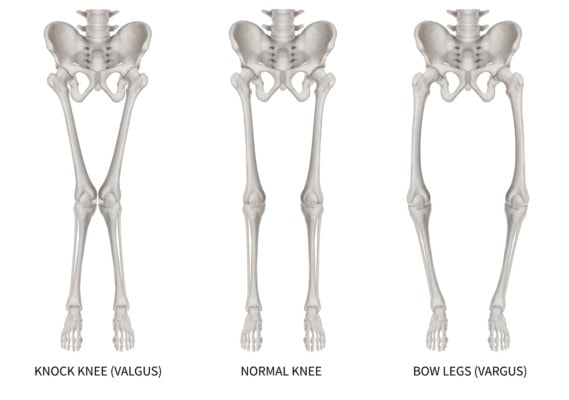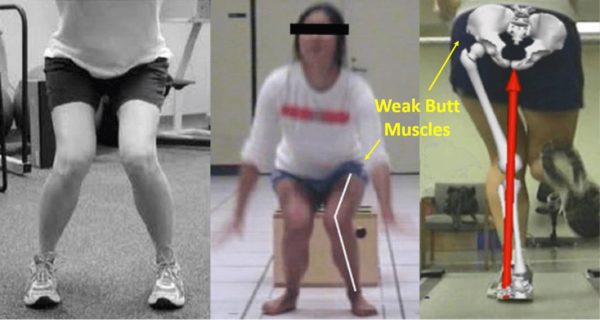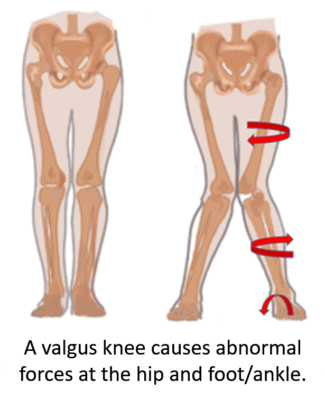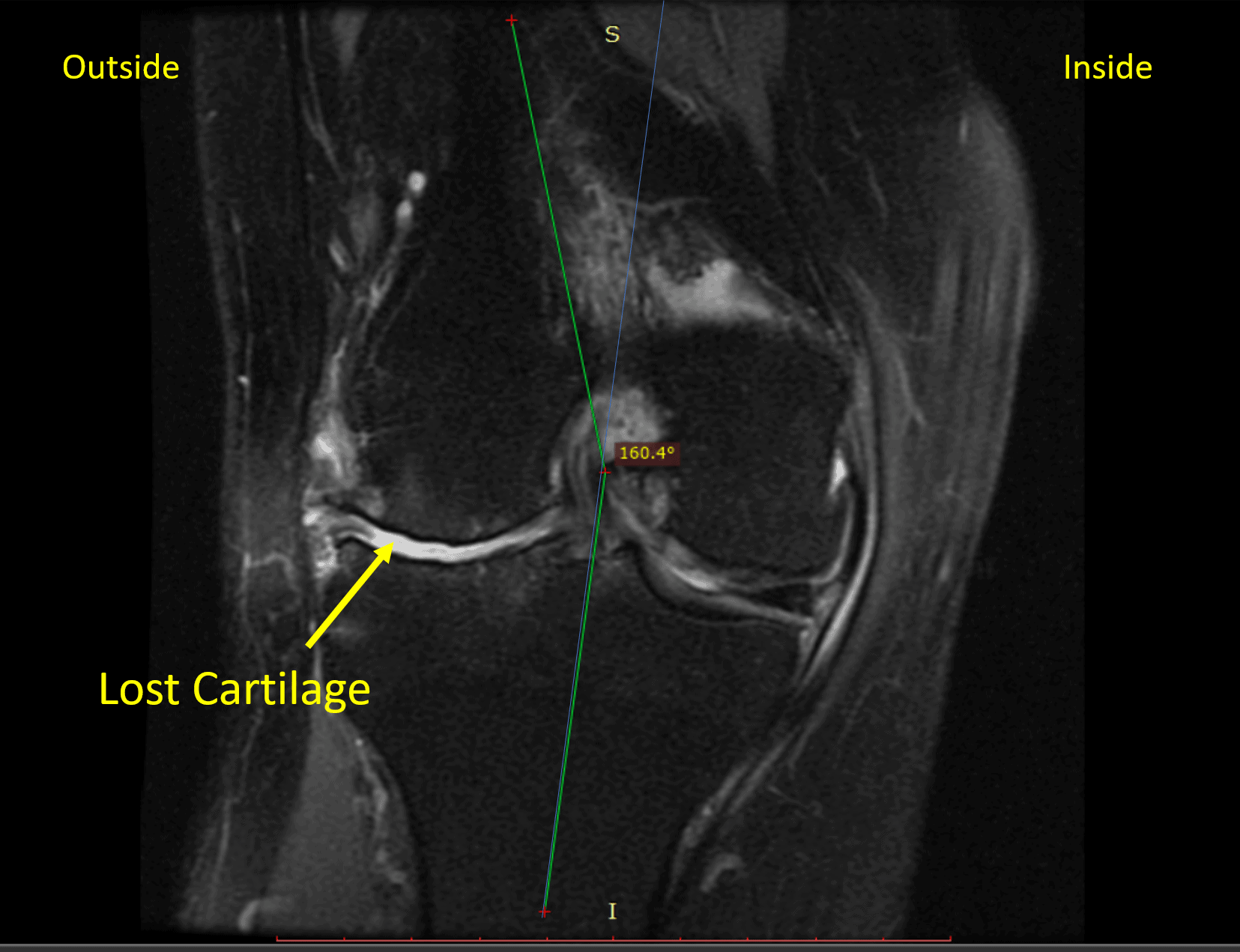Can You Treat a Valgus Knee Without Surgery?
On this page:
- What is valgus knee?
- What causes valgus knee?
- How does valgus knee affect the kinetic chain?
- Are there different types of valgus knee?
- How is valgus deformity treated?
- Valgus knee patient story
A valgus knee is what doctors call “knock-kneed.” These patients can get arthritis on the outside and when that happens, oftentimes they’re offered invasive surgery. However, does that need to be done? Today we’ll review valgus knee and also follow one patient’s journey to recovery without surgery.
What Is Valgus Knee?

Intarapong/Shutterstock
The knee joint should be straight as it’s viewed from the front and when it angles inward, this is called a valgus knee. The more common term you likely know is “knock-kneed”. This comes from the observation that the valgus can become so bad that the knees can touch.
What causes valgus deformity? The most common thing we see as a cause is a prior surgery where the outside (lateral) mensicus is surgically removed after a tear. This causes a collapse of this compartment of the knee because this is a natural spacer.
Another cause is an untreated medial collateral ligament sprain or tear which allows the inside knee bones to spread apart. This problem is also more common in women who have wider hips than men, which causes more inward pressure on the knees.
What Causes Valgus Knee?
A valgus knee can be caused by long-term weakness in the hip. For example, weak butt muscles (gluteus maximus) have been associated with medial knee collapse.

Early on, long before the knee arthritis or change in shape of the knee is seen, it’s these weak muscles that allow the knee to collapse inward during stress (as shown here). This has also been associated with a high rate of ACL injuries in girls, as it places stress on that and other ligaments (6).
But the biggest problem with knee valgus is that it puts more pressure on the outside (lateral) knee compartment. This extra pressure can lead to tears or degeneration in the lateral meniscus or cartilage. This means that the patient can develop lateral knee arthritis.
How Does Valgus Knee Affect the Kinetic Chain?
A valgus knee doesn’t just cause problems in the lateral compartment of the knee. It also significantly impacts the joints above and below the knee. For example, it causes internal rotation of the hip and places stretch forces on the outside hip structures like the ITB. It can also lead to excessive pronation of the foot, which places abnormal forces on the ankle.
Remember that your knee is just one link of a kinetic chain that constitutes a biomechanical machine called a leg. The purpose of that machine is to transfer forces from your hip down to the ground, so if the middle part (knee) is messed up, the other parts are impacted.

Are There Different Types of Valgus Knee?
First, like any condition, there is a severity grade. The knee is usually considered more severe if the valgus angle is more than 20 degrees from straight (5). This problem is also classified by whether the ligaments on the side (collaterals) are tight or loose.
How Is Valgus Deformity Treated?
Most patients with valgus knee who end up with lateral compartment arthritis start with treatments like cortisone steroid shots. The problem? These have been shown to kill off needed cartilage (1).
Some will get lateral meniscus tears due to the added pressure, but surgery for this condition has also been shown to be not helpful with three large studies showing that it’s no better than fake surgery or physical therapy (2-4).
Hence, that usually leaves invasive knee replacement as the court of last resort. In that surgery, the knee joint in total (or just the outside part) is amputated surgically and a prosthesis is inserted.
Pilar’s Story
Pilar is a middle-aged woman with a right-sided valgus knee who needed Celebrex just to function. She had the typical lateral compartment arthritis and was having difficulty climbing stairs and walking for any length of time. Her MRI is below:

The blue line is what the knee angle should be and the red line is actual, so she’s about 20 degrees off neutral. There is lost cartilage on the outside of the knee. This is severe medial compartment arthritis that would normally require a knee replacement.
On exam, her MCL (inside knee ligament) and ACL (internal knee ligament) were loose, causing knee instability. Hence, I took bone marrow containing stem cells from her hip and concentrated that fraction of cells in the lab and then re-injected that using x-ray and ultrasound guidance into the following structures:
- ACL
- MCL
- Medial patellofemoral fascia
- Lateral compartment
Now about 4 months after the procedure she reports 80% relief without invasive orthopedic surgery like a knee replacement. Her MCL and ACL ligaments are tighter so the knee is more stable now. Her hip pain is also improved, likely because a valgus knee puts pressure on the outside of the hip.
The upshot? A valgus knee with arthritis used to mean a big knee replacement surgery. Now that’s often no longer the case.
_________________________________________________________
References
(1) McAlindon TE, LaValley MP, Harvey WF, et al. Effect of Intra-articular Triamcinolone vs Saline on Knee Cartilage Volume and Pain in Patients With Knee Osteoarthritis: A Randomized Clinical Trial. JAMA. 2017;317(19):1967-1975. doi:10.1001/jama.2017.5283
(2) Katz JN, Brophy RH, Chaisson CE, et al. Surgery versus physical therapy for a meniscal tear and osteoarthritis [published correction appears in N Engl J Med. 2013 Aug 15;369(7):683]. N Engl J Med. 2013;368(18):1675-1684. doi:10.1056/NEJMoa1301408
(3) Sihvonen R, Paavola M, Malmivaara A, et al. Arthroscopic partial meniscectomy versus sham surgery for a degenerative meniscal tear. N Engl J Med. 2013;369(26):2515-2524. doi:10.1056/NEJMoa1305189
(4) Sihvonen R, Englund M, Turkiewicz A, Järvinen TL; Finnish Degenerative Meniscal Lesion Study Group. Mechanical Symptoms and Arthroscopic Partial Meniscectomy in Patients With Degenerative Meniscus Tear: A Secondary Analysis of a Randomized Trial. Ann Intern Med. 2016;164(7):449-455. doi:10.7326/M15-0899
(5) Nikolopoulos D, Michos I, Safos G, Safos P. Current surgical strategies for total arthroplasty in valgus knee. World J Orthop. 2015;6(6):469-482. Published 2015 Jul 18. doi:10.5312/wjo.v6.i6.469
(6) Quatman CE, Hewett TE. The anterior cruciate ligament injury controversy: is “valgus collapse” a sex-specific mechanism?. Br J Sports Med. 2009;43(5):328-335. doi:10.1136/bjsm.2009.059139

If you have questions or comments about this blog post, please email us at [email protected]
NOTE: This blog post provides general information to help the reader better understand regenerative medicine, musculoskeletal health, and related subjects. All content provided in this blog, website, or any linked materials, including text, graphics, images, patient profiles, outcomes, and information, are not intended and should not be considered or used as a substitute for medical advice, diagnosis, or treatment. Please always consult with a professional and certified healthcare provider to discuss if a treatment is right for you.